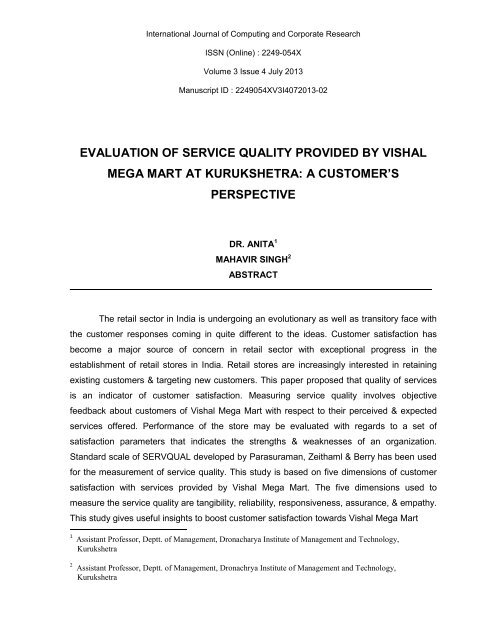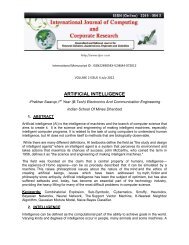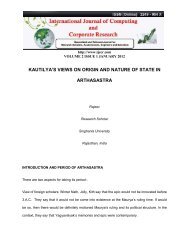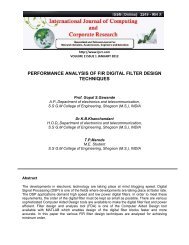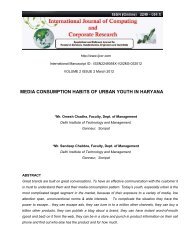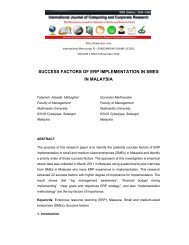evaluation of service quality provided by vishal mega ... - Ijccr.com
evaluation of service quality provided by vishal mega ... - Ijccr.com
evaluation of service quality provided by vishal mega ... - Ijccr.com
You also want an ePaper? Increase the reach of your titles
YUMPU automatically turns print PDFs into web optimized ePapers that Google loves.
International Journal <strong>of</strong> Computing and Corporate ResearchISSN (Online) : 2249-054XVolume 3 Issue 4 July 2013Manuscript ID : 2249054XV3I4072013-02countries, the retail sector has a highly developed system <strong>of</strong> supply chain. Howeverdevelopments in supply chain in Indian retail sector has been quite slow.Other areas that need attention for the growth <strong>of</strong> the Indian retail sector include dutyand tax structures, infrastructure, rising land prices and effective trend forecasting. Trendforecasting needs to be done in the country especially in the segments <strong>of</strong> cosmetics, appareland footwear for this will help the retail <strong>com</strong>panies to curtail their expenses substantially.Another area that requires attention is manpower for it is estimated that <strong>by</strong> 2012, the Indianretail sector will suffer from shortage <strong>of</strong> manpower <strong>by</strong> about a million people. The chains inthe Indian retail sector need to frequently change their stocks and also adopt concepts likehome delivery. If all these areas are given immediate attention then the growth phase <strong>of</strong>Indian retail sector growth would be very fast paced. The Indian retail sector would thenwitness the setting up <strong>of</strong> retail parks like they are flourishing in Europe. Further, the growth <strong>of</strong>the Indian retail sector would help in making India ready for big retailers <strong>by</strong> 2015- 2016.Also, the rise in the working population which is young, pay- packets which are hefty,more nuclear families in urban areas, rise in the number <strong>of</strong> women working, more disposablein<strong>com</strong>e and customer aspiration, western influences and growth in expenditure for luxuryitems. All these are the factors are very vital to the growth in Indian organized retailsector. Many Indian <strong>com</strong>panies have entered the retail industry in India and this is also afactor in the growth <strong>of</strong> Indian organized retail sector. Reliance Industries Limited is planningto invest US$ 6 billion in the organized retail sector in India <strong>by</strong> opening 1500 supermarketsand 1000 hypermarkets. Bharti Tele<strong>com</strong> is planning a joint venture worth £ 750 million withTesco a global retail giant. Pantaloons are planning to invest US$ 1 billion in order toincrease its retail space to 30 million square feet. Such huge investments are also a factor inthe growth <strong>of</strong> the organized retail sector in India.Research ObjectivesThe most important objective <strong>of</strong> the study is to determine the gap in <strong>service</strong>s <strong>of</strong>fered<strong>by</strong> Vishal Mega Mart with special reference to the expectations <strong>of</strong> the customers & <strong>service</strong>s
International Journal <strong>of</strong> Computing and Corporate ResearchISSN (Online) : 2249-054XVolume 3 Issue 4 July 2013Manuscript ID : 2249054XV3I4072013-02The reliability & validity <strong>of</strong> the research depends on the five dimensions <strong>of</strong> the SERVQUAL(i.e. reliability, assurance, tangibility, empathy, & responsiveness.) & the demographic pr<strong>of</strong>ile<strong>of</strong> the respondents.Demographic Pr<strong>of</strong>ile <strong>of</strong> the RespondentsThe demographic pr<strong>of</strong>ile <strong>of</strong> the respondents is presented in Table. It reveals that 85%<strong>of</strong> the respondents are <strong>of</strong> age below 35 Years. This reflects that customers below 35 Yearsform the major opinion <strong>of</strong> this study. In terms <strong>of</strong> gender 84% <strong>of</strong> the respondents are male &16% are female. By looking at the marital status <strong>of</strong> the respondents, it reflects that 55% aremarried & remaining 45% are unmarried. Majority <strong>of</strong> the respondent’s (89.19%) lies in thein<strong>com</strong>e bracket Rs. 10001 to 50000 per months, this show that the respondents are frommedium in<strong>com</strong>e group <strong>of</strong> the society. The research reflects that maximum respondents arehaving 3 to 4 members in their family. Table 1 further reflects that 89% <strong>of</strong> the respondentsvisiting Vishal Mega Mart from last 7 to 18 months. But still 80% <strong>of</strong> the respondents visitother retail stores also. This reflects that the customers are not loyal to one particular retailstore.SERVQUAL Scores <strong>of</strong> Customer Expectations & PerceptionsTable 1 explains the demographic pr<strong>of</strong>ile <strong>of</strong> the respondents. Table 2 revealsstatistics regarding the mean score difference between customer’s expectation & perceptionin relation to each element <strong>of</strong> five dimensions <strong>of</strong> <strong>quality</strong> <strong>of</strong> <strong>service</strong>s further the table showsthe percentage <strong>of</strong> satisfaction <strong>of</strong> the respondents in relation to each statements. Table 3reveals the mean score <strong>of</strong> individual dimension & their percentage <strong>of</strong> satisfaction in relationto each dimension.On the basis <strong>of</strong> the mean score calculated for individual dimensions, it was found thatcustomers have ranked tangibility dimension as first. The ambience which constitutes
International Journal <strong>of</strong> Computing and Corporate ResearchISSN (Online) : 2249-054XVolume 3 Issue 4 July 2013Manuscript ID : 2249054XV3I4072013-02physical facility along with employees is noticed more <strong>by</strong> customers <strong>by</strong> entering the retailstore. On an average 62.63% <strong>of</strong> the respondents are satisfied with the elements <strong>of</strong> tangibility.Assurance is ranked second <strong>by</strong> customers <strong>of</strong> the retail store. The customers feel safe &confident due to this factor. It also includes employees being knowledgeable and courteousto customers. It can be seen in the table that 61.53% <strong>of</strong> the respondents are satisfied withthe elements <strong>of</strong> assurance.Responsiveness which entails to help customers & deliver prompt <strong>service</strong>s is rankedthird <strong>by</strong> the customers. This dimension includes prompt & good <strong>service</strong>s. This dimension isalso including timing <strong>of</strong> <strong>service</strong> & willingness <strong>of</strong> employee to help customers. Overall 61.09%<strong>of</strong> the respondents are satisfied with this dimension. Vishal Mega Mart needs to focus moreon providing benefits, meeting needs <strong>of</strong> the customers & solving their problem. A retail storethat provides greater benefits to customers, <strong>quality</strong> <strong>service</strong>s & courteous employees isalways the winner in the market place. Attributes under the dimension empathy is rankedfourth <strong>by</strong> the customers. This factor ensures individual attention to customers, keeping theirinterest & needs as priority. 60.21% <strong>of</strong> customers are satisfied with the elements <strong>of</strong> thisdimension. Giving time & personal <strong>service</strong> are important in retail sector. Vishal Mega Martshould focus on understanding the requirements <strong>of</strong> the customers & giving them individualattention. It will allow the store to understand individual customers better & meet their needswith personalized <strong>service</strong>s. Store need to ensure that customers are able to register their<strong>com</strong>plaints. It should be remember that customers who <strong>com</strong>plain tend to be more loyal thanthose who had a problem but failed to <strong>com</strong>plain (Raddon, 1987).Reliability is ranked fifth. The reliability dimension is the descriptor <strong>of</strong> the functional &out<strong>com</strong>e <strong>quality</strong> (Brady & Cronin, 2001). This implies that store should be able to performwhat they purport to perform-whether it is functional <strong>quality</strong> aspect or the out<strong>com</strong>e <strong>quality</strong>aspect. The store should also be accurate & transparent in their transaction. Overall 60% <strong>of</strong>the respondents are satisfied with the elements <strong>of</strong> this dimension.Conclusion
International Journal <strong>of</strong> Computing and Corporate ResearchISSN (Online) : 2249-054XVolume 3 Issue 4 July 2013Manuscript ID : 2249054XV3I4072013-02Learning to understand customer’s needs will enable retail store to enhance customer<strong>service</strong>s & reduce the customers retailing costs. These results should be useful to VishalMega Mart. GAP Analysis between expectation & deliverables should be carried out regularlyto measure the current level <strong>of</strong> satisfaction for customers & to know what the pluses &minuses <strong>of</strong> the store are, so as to improve those factors on which it is losing out.This study is based on the perception <strong>of</strong> customers in Kurukshetra city. These results cannotbe generalized for other branches <strong>of</strong> Vishal Mega Mart.Table 1: Demographic Pr<strong>of</strong>ile <strong>of</strong> the RespondentsVariable Frequency PercentageAge Factor (years)18-24 25 25%24-35 60 60%35-50 10 10%Above 50 05 05%TOTAL 100 100%GenderMale 84 84%Female 16 16%TOTAL 100 100%Marital StatusMarried 55 55%Unmarried 45 45%TOTAL 100 100%In<strong>com</strong>e LevelBelow 10000 02 02.70%10001-25000 37 50.00%25001-50000 29 39.19%
International Journal <strong>of</strong> Computing and Corporate ResearchISSN (Online) : 2249-054XVolume 3 Issue 4 July 2013Manuscript ID : 2249054XV3I4072013-02Mean Score <strong>of</strong> StatementsDimensions Service Quality Elements ExpectatTangibility 1. Up- to- date equipment 4.55 Score 2.84 Score 1.71 e2. Appealing physical facilities 4.55 2.86 1.693. Well dressed and neat & clean 4.55 2.84 1.714. Appearance and ambience <strong>of</strong> 4.55 2.85 1.70AVERAGE4.55 2.85 1.7SCORE-ionPerceptiReliability 1. Adherence to scheduled time lines. 4.55 2.61 1.942. Sympatric and reassuring in solving 4.55 2.94 1.613. Dependable Services. 4.55 2.82 1.734. Promising a definite time date schedules 4.55 2.72 1.835. Accurate and transparent transactions. 4.55 2.87 1.68AVERAGE4.55 2.73 1.82SCOREResponsive 1. Employees expected to provide schedule 4.55 2.86 1.692. Is it realistic to expect prompt and good 4.55 2.83 1.723. Employee’s willingness to help. 4.55 2.92 1.634. Employees are never busy responding to 4.55 2.52 2.03AVERAGE4.55 2.78 1.77SCOREAssurance 1. Employee’s trustworthiness 4.55 2.82 1.732. Feeling safe /secure with transacting with 4.55 2.72 1.833. Courteousness and politeness <strong>of</strong> 4.55 2.88 1.674. Employees have the knowledge to do their 4.55 2.81 1.74AVERAGE4.55 2.80 1.75SCOREEmpathy 1. Individual attention <strong>by</strong> <strong>service</strong> provider. 4.55 2.67 1.882. Employees pay individual attention to 4.55 2.73 1.823. Employees know the customer’s need and 4.55 2.75 1.704. Vishal Mega Mart keeps the customer’s 4.55 2.79 1.765. Convenient operations according to 4.55 2.76 1.77AVERAGE4.55 2.74 1.81SCORE-onGapscor
International Journal <strong>of</strong> Computing and Corporate ResearchISSN (Online) : 2249-054XVolume 3 Issue 4 July 2013Manuscript ID : 2249054XV3I4072013-02Table 3: Mean Score <strong>of</strong> Five DimensionsDimensions Expectations Perception GAP (E-P) % <strong>of</strong>SatisfactionTangibility 4.55 2.85 1.7 62.63Reliability 4.55 2.73 1.82 60.00Responsiveness 4.55 2.78 1.77 61.09Assurance 4.55 2.80 1.75 61.53Empathy 4.55 2.74 1.81 60.21Overall Results 4.55 2.78 1.77 61.09Figure 1: GAP in Five Dimension <strong>of</strong> Service QualityFigure 2: GAP in Tangibility
International Journal <strong>of</strong> Computing and Corporate ResearchISSN (Online) : 2249-054XVolume 3 Issue 4 July 2013Manuscript ID : 2249054XV3I4072013-02Figure 3: GAP in Reliability
International Journal <strong>of</strong> Computing and Corporate ResearchISSN (Online) : 2249-054XVolume 3 Issue 4 July 2013Manuscript ID : 2249054XV3I4072013-02Figure 4: GAP in ResponsivenessFigure 5: GAP in Assurance
International Journal <strong>of</strong> Computing and Corporate ResearchISSN (Online) : 2249-054XVolume 3 Issue 4 July 2013Manuscript ID : 2249054XV3I4072013-02Figure 6: GAP in Empathy
International Journal <strong>of</strong> Computing and Corporate ResearchISSN (Online) : 2249-054XVolume 3 Issue 4 July 2013Manuscript ID : 2249054XV3I4072013-02References:1. Ali, j., Kapoor, S., & Moorthy, J. 2010, Buying behaviour <strong>of</strong> consumers for foodproducts in an emerging economy. British Food Journal, 112 (2).2. Ahmed, P.K and Rafiq, M. (1995), “The Role <strong>of</strong> Internal Marketing in theImplementation <strong>of</strong> Marketing Practice: Applied Marketing Science”, Vol.-1, No.4, andPp.32-51.3. Ahmed, P.K and Rafiq, M. (2000), A Meta-Model <strong>of</strong> Internal Marketing, R.J. Varey &B.A.Zlewis, (Ed) Internal Marketing: Dimensions for Management. (p.223-237),London: Routeledge.4. Ahmed, P.K and Rafiq, M. (2002), Internal Marketing – Tools and conceptsforcustomer - focused management. Oxford: Butterworth-Heinemann.5. Albert Caruana, Peter Calleya (1998), “The Effect <strong>of</strong> Internal Marketing onOrganizational Commitment Among Retail Bank Managers”, International Journal <strong>of</strong>Bank Marketing, 16(3), p. 108-116.6. Bajaj, C., Tuli, R. & Srivastva, N.2005, Retail Management, Oxford University Press,New Delhi.7. Bak, C.A., Vogt L.H., George, W.R. & Greentree, I.R. (1994). Management <strong>by</strong> Team:An innovative tool for running a <strong>service</strong> organization through internal marketing,Journal <strong>of</strong> Services Marketing, 8(1), 37-47.8. Berman, B. and J.R. Evans, “Retail Management- A Strategic Approach”, 8th ed.,2001, Prentice- Hall.
International Journal <strong>of</strong> Computing and Corporate ResearchISSN (Online) : 2249-054XVolume 3 Issue 4 July 2013Manuscript ID : 2249054XV3I4072013-029. Berman, B. and J.R. Evans, “Retail Management- A Strategic Approach”, 9th ed.,2005, Prentice- Hall.10. Berry, L.L. (1981), “The Employee as Customer”, Journal <strong>of</strong> Retail Banking, Vol.3,March, Pp.25-80.11. Berry, L, L. & Parasuraman, A. (1991) Marketing Services. New York: The FreePress.12. Berry, L, L. & Parasuraman, A. (2000). Service marketing starts from within. R.J.Varey & B, A. Lewis. (EDS) Internal Marketing: Directions for Management. (p. 176-191). London: Routeldge.13. Cahill, D.J. (1996). Internal marketing: Your Company’s next stage <strong>of</strong> growth. NewYork: The Haworth Press.14. Goyal, B. & Aggarwal, M. 2009, organized retailing in India-Drivers facilitators andSWOT analysis, Asian Journal <strong>of</strong> Management Research Volume 2 Issue 1.15. Satish, D. & Raju, V. 2010, the Growth <strong>of</strong> Indian Retail Industry. Advances inManagement, 3(7), pp 15-1916. Srivastava, R.K. 2008, changing retail scene in India. International journal <strong>of</strong> retailand distribution management, 36(9).17. Talwar, S.L. (2010), organized retail in northern and western states. RetailerMagazine, 5(7).18. Thang, D.C.L. & Tan, B.L.B. (2003), Linking consumer perception to preference <strong>of</strong>retail stoers: An empirical assessment <strong>of</strong> the multi-attributes <strong>of</strong> store image. Journal<strong>of</strong> Retailing and Consumer Services, 10(4).


